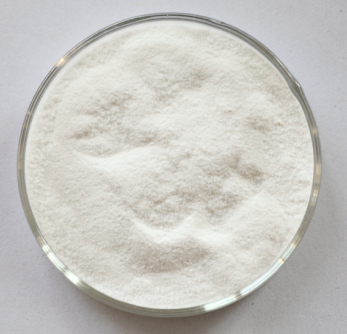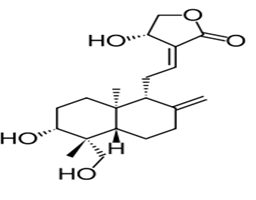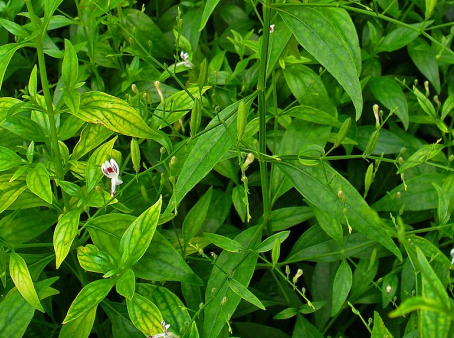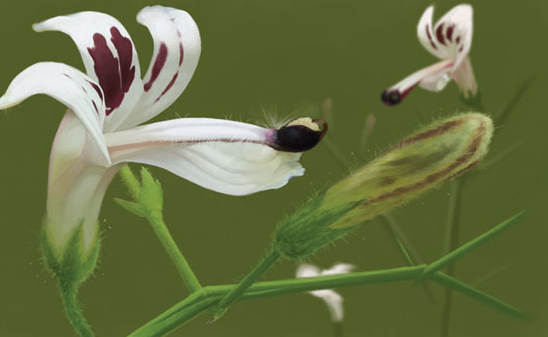Hot Selling for Andrographis Extract in Costa Rica
Hot Selling for Andrographis Extract in Costa Rica Detail:
[Latin Name] Andrographis paniculata(Burm.f.)Nees
[Plant Source] Whole herb
[Specification] Andrographolides 10%-98% HPLC
[Appearance] White powder
Plant Part Used: Herb
[Particle size] 80Mesh
[Loss on drying] ≤5.0%
[Heavy Metal] ≤10PPM
[Storage] Store in cool & dry area, keep away from the direct light and heat.
[Shelf life] 24 Months
[Package] Packed in paper-drums and two plastic-bags inside.
[Net weight] 25kgs/drum
[What is Andrographis?]
Andrographis paniculata is a bitter tasting annual plant, referred to as the “King of Bitters.” It has white-purple flowers and it is native to Asia and India where it has been valued for centuries for its numerous medicinal benefits. Over the past decade, andrographis has become popular in America where it is often used alone and in combination with other herbs for a variety of health purposes.
[How does it work?]
According to Memorial Sloan-Kettering Cancer Center, the active ingredient in andrographis is andrographolides. Due to the andrographolides, andrographis has potent anti-inflammatory and antimalarial properties. It also has antimicrobial properties, meaning it can help to fight off and prevent infections from harmful microorganisms such as viruses, bacteria and fungi. In addition, andrographis is a powerful antioxidant and it can help to prevent free radical induced damage to your cells and DNA
[Function]
Cold and Flu
Scientists have discovered that andrographis helps to boost the immune system by stimulating the body’s production of antibodies and macrophages, which are large white blood cells that scavenge harmful microorganisms. It is taken for both the prevention and treatment of the common cold, and it is often referred to as Indian echinacea. It might help lessen the severity of cold symptoms such as sleeplessness, fever, nasal drainage and sore throat.
Cancer, Viral Infections and Heart Health
Andrographis may also help to prevent and treat cancer, and preliminary studies done in test tubes found that extracts of andrographis help to treat stomach, skin, prostate and breast cancer. Due to the herb’s antiviral properties, andrographis is used to treat herpes and it is also currently being studied as a treatment for Aids and HIV as well. Andrographis also promotes heart health and can help to prevent the formation of blood clots as well as to dissolve already formed blood clots. In addition, the herb relaxes smooth muscles in the walls of blood vessels and thereby helps to reduce high blood pressure.
Additional Benefits
Andrographis is used to promote gallbladder and digestive health. It also helps to support and strengthen the liver and it is used in combination with other herbs in several Ayurvedic formulations to treat liver disorders. Finally, andrographis extracts taken orally have been found to help neutralize the poisonous effects of snake venom.
Dosage and Precautions
The therapeutic dose of andrographis is 400 mg, twice daily, for up to 10 days. Although andrographis is considered safe in humans, the NYU Langone Medical Center warns that animal studies suggest that it may impair fertility. Andrographis may cause unwanted side effects such as headaches, fatigue, allergic reactions, nausea, diarrhea, altered taste and pain in the lymph nodes. It may also interact with certain medications and as with any supplement you should consult your health care practitioner before taking the herb.
Product detail pictures:

Related Product Guide:
With dependable high quality approach, great reputation and excellent customer support, the series of products and solutions produced by our firm are exported to lots of countries and regions for Hot Selling for Andrographis Extract in Costa Rica , The product will supply to all over the world, such as: Canada, Cyprus, Florida, If you give us a list of products you are interested in, along with makes and models, we can send you quotations. Please email us directly. Our goal is to establish long-term and mutually profitable business relationships with domestic and overseas clients. We look forward to receiving your reply soon.
Fayed, A.E.
Detection of Domiati cheese adultration with palm oil.
Identification of palm oil in some fatty products.
Influence of insecticide residues on growth and activity of Streptococcus diacetilactis and Leuconostoc cremoris.
Presistence of Fenvalerate pyrethroid in milk in relation to lactic acid bacteria.
Susceptibility of some lactic acid bacteria to different insecticides.
Ultrafiltration of reconstituted skimmilk powder in relation to the rennet ability and casein fractions.
Application of ultrafiltration technique for production of low calorie recombined butter rich in protein.
Ultrafiltration whey protein concentrate as a substitute for egg white in pie topping meringue.
Production of aromatic recombined butter by using different milk solids not fat ingredients.
Distribution of some insecticides in milk fat globule materials.
Keeping quality of market butter oil in comparison with samna.
Ultrafiltration whey concentrate as protein fortifier in macaroni manufacture from wheat flour.
Fiber fortification of ice milk by means of cooked wheat.
Enhancement of milk fat quality by conversion into recombined butter in relation to some properties of skimmilk powder used.
Incidence of some environmental pollutants in milk and its products at great Cairo markets.
Substitution of non fat milk solids in ice cream with ultrafiltration whey protein concentrate.
Milk preparedness for bacterial growing in relation to environmental contaminants.
Quality evaluation of imported skimmilk prowder.
Effect of milk fat quality on the properties of recombined butter.
Utilization of some food industry wastes prepared as milk fat antioxidants.
Effect of microwave treatment on bacteriological and keeping quality of buffaloes milk.
Monitoring some contaminants during the manufacture of some conventional dairy products.
Ultrafiltration membrance permeability of some milk contaminants.
Physical and organoleptic properties of yoghurt made from standardized buffalo’s milk fortified with total milk proteinate.
Production and characterization of bacterial coagulants as calf rennet replacer for Egyptian cheesemaking.
The profile of market Domiati cheese with emphasis on biogenic amines occurrence.
Production of bacteriocin using ultrafiltrated milk permeate.
The use of ultrafiltration technique for recovery of nisin-like bacteriocin.
Comparative supplementation of ice cream mixes by ultrafiltrated skimmilk retentate or whey proteins concentrate.
Production of low calorie ice cream.
Comparative acylation methods of ultrafiltrated whey proteins concentrate with emphasis on the functional properties.
Effect of using alternative combination of glucono delta lactone with lactic starter culture on the properties of UF-white soft cheese during cold storage.
Brevibacterium linens as an adjunct starter culture in low fat Ras cheese.
Influence of some preservatives on cast UF-white soft cheese properties during cold storage.
Antifungal efficiency of a starter culture containing Lactobacillus reutrei during Ras cheese ripening.
Influence of formaldehyde and hydrogen peroxide as preservatives on the properties of buffalo’s milk proteins.
Comparative evaluation between Selandid and Maltodextrin as fat mimetic in low fat Ras cheesemaking.
Production of probiotic low calorie sour cream.
Production of light calorie whipped cream using mimetic fats and stevioside.
Effect of Transglutaminase on the quality of yoghurt made with different milk protein sources.
Biological evaluation of cow’s milk yoghurt fortified with different source of milk proteins.
Antifungal efficiency of a starter culture containing some Lactobacillus species during Ras cheese ripening.
Utilization of ultrafiltrated whey protein concentrate in the manufacture of reduced fat processed cheese spread.
Biological Attributes of bio-yoghurt versus the conventional one fed in spray dried form.
Effect of cow’s milk treatment with transglutaminase on the composition and quality of yoghurt with particular reference to its biological value.
Performance of transglutaminase as body stabilizer in Tallaga cheese made from ultrafiltrated cow’s milk retentate.
Utilization of mushroom powder for substituting dried skimmilk in the manufacture of processed cheese spread.
Glycoprotein fortification of bioyoghurt.
Improvement of yoghurt efficiency as functional food by glycoprotein fortification.
Application of ultrafiltration technique in the manufacture of reduced-calorie frozen bioyoghurt in synbiotic form.
Healthy multifunctional spectra of milk glycoproteins and their fragments.
Production of carbonated stirred yoghurt fortified with some physiological active ingredients.
Physiologically Active Ingredients as Yoghurt Fortifiers.
Rheological, microstructural and biological characteristics of probiotic ultrafiltrated skimmed milk cheese in comparison with the conventional Kariesh cheese.
Economics scale for processing of white soft cheese in Egypt.
The supplier abide the theory of "quality the basic, trust the first and management the advanced" so that they can ensure a reliable product quality and stable customers.









